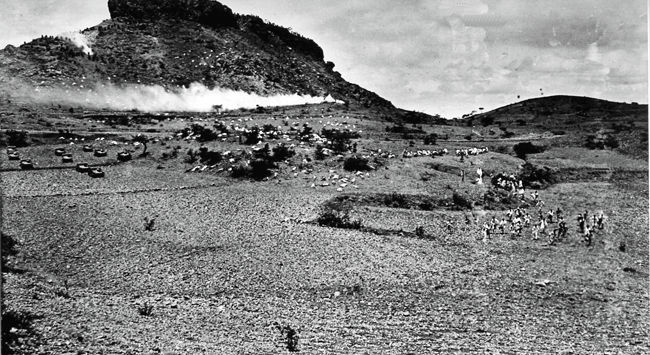Conquest of Abyssinia 1935-36
By sebastianokellyThe pretext for the Italian invasion of Ethiopia in December 1935 was an unexceptional shoot-out on the Ethiopian-Italian Somaliland border. But the Italian army was eager to avenge the humiliating defeat of Adowa in 1896 and, after Mussolini had whipped Italians into a frenzy, he was in no mood to back down. Ironically, Emperor Haile Selassie’s faith in international diplomacy and his decision to appeal to the League of Nations probably made war inevitable. Britain and France tried to wriggle out of their obligations to support a member of the League of Nations. In the end, they imposed ineffectual sanctions, which infuriated Italy but did not undermine its war effort. The British dared not close the Suez Canal to Italian shipping, which would have provoked war.
The long term consequences were worse than the conquest itself. The triumph of Italian arms went to Mussolini’s head, and the democracies’ hostility pitched Italy into alliance with Nazi Germany. The road to 1939 was set by the Abyssinian crisis.
Curiously, the British public adored the Ethiopian emperor, finding him almost as picturesque as Gandhi, when he arrived in exile at Victoria Station in 1936. The veteran suffragette Sylvia Pankhurst dedicated herself to his cause, and her son Richard still lives in the house in Addis Ababa that the emperor gave her.
Pankhurst dismissed Amedeo as an intransigent fanatic for his guerrilla escapades during the Second World War. But Richard happily came to meet him at the Italian Embassy in London in 2002 for the launch party to celebrate my biography.
The Italian ambassador was rather wary about meeting the famous Richard Pankhurst, who was campaigning for the return of the “column of Axum”, which had been removed in 1937 and sited by the Duce above the Circus Maximus in Rome.
“You will get your column back,” the ambassador hastily assured him.
“When?” replied Pankhurst.
“Soon.”
“I have organised a demonstration outside your embassy next week.”
“Ma … ma … Well, not that soon.”
The column finally returned to Ethiopia in 2008.
Here’s the BBC link: http://news.bbc.co.uk/1/hi/7505957.stm

October 1935: Amedeo and the Spahys di Libya lead the advance into Ethiopia, with columns of Italian infantry to the rear.

The opposing armies: Lightly armed Ethiopia infantry set out from the streets of Addis Ababa to face an enemy armed with tanks, machine guns, barbed wire and poisoned gas. Nonetheless, much of the fighting was hand-to-hand and the Spahys di Libya, the cavalry unit to which Amedeo had had himself attached, was in the thick of it. I found this photograph in the old Daily Mail picture library. It was probably taken by the unfortunate photographer who had to accompany Evelyn Waugh to the war. (Stuck in Addis Ababa far from the front, Waugh lost interest and – with a final cheer for the Italians, who he delighted in supporting in order to upset left-wing fellow journalists – he headed for Jerusalem for Christmas.)

Blackshirts and a bad man: Marshal Rodolfo Graziani reviews a Black Shirt unit on the Ethiopian-Somaliland front, where he commanded. Black Shirts were not comparable to the elite, ideological fanatics of the Waffen SS. All were supposedly dedicated Fascists, but they were more akin to a militia, with many being middle-aged World War 1 veterans. Amedeo rated these older veterans highly in the later battles against the British.


Amedeo photographed with his Spahy orderly photographed on December 26 1935, the day after the cavalry actions at Selaclaca. He is riding Sandor, the tall Arab horse he had brought with him from Libya, and would ride again in his actions against the British. During the melee, Amedeo was wounded in the left hand by fragments of an explosive bullet that hit the pommel of his saddle. Had it been any higher, he would have suffered a fatal wound. For years, Amedeo wore a leather gauntlet to keep the hand from closing in on itself, and even in old age he always wore curious little mittens. The dedication of the photograph is to his Uncle Rodolfo, the father of his future wife Beatrice. Oddly, the original photograph was mistakenly reversed when it was printed, making it appear that his right hand were wounded. It is usually reproduced incorrectly.
The following five extraordinary photographs document a cavalry charge by the Spahys di Libya in early 1936. I found them in one of Amedeo’s albums at his house in Kentstown, Co Meath, after first paying little attention to them. The prints were small (about 3×4 cms), in poor condition and the detail was difficult to make out without a magnifying glass. Only then did I realise what I was looking at.

Ethiopian irregulars disadvantaged in white, confronted their better-armed adversaries. Italian infantry on the mountain lay down a barrage, as ten light Fiat Ansaldo tanks advance past the Ethiopian positions. Some realise the danger and start fleeing.

The Spahys di Libya charge over the hill and the Italian tanks push forward, completely cutting off the beleagured Ethiopians.

Panicking warriors flee amid the Italian tanks, which are armed with twin machine guns, and the bodies (right) begin to pile up.

The Spahy cavalry charge on leaving the remaining Ethiopians to be mopped up by the Italian infantry.


